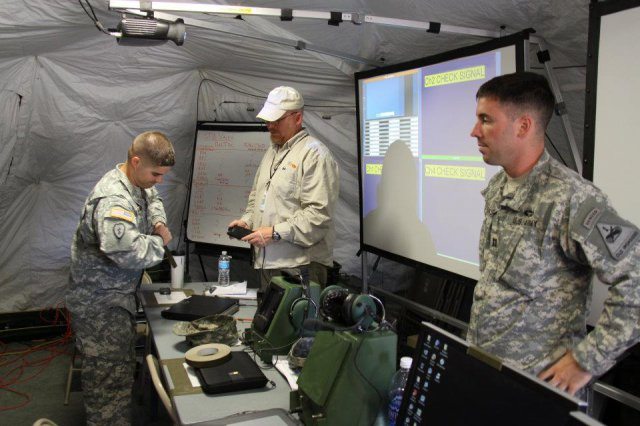For Army units, fielding and resetting sophisticated mission command and situational awareness equipment is an intricate process. The interdependent capabilities include state-of-the-art communications systems, the network and all the enablers, which require training to take place in a logical order.
But relieving some of the pressure on Soldiers is Unit Set Fielding, or USF, a process that serves as a one-stop-shop for planning, expediting and implementing the fielding and training of Command, Control, Communications, Computers, Intelligence, Surveillance and Reconnaissance, also known as C4ISR, capabilities.
Now, after the USF process has helped efforts to digitize Army units during the wars in Iraq and Afghanistan, the process will continue to bring efficiencies as the drawdown continues and the Army realigns its forces.
“We synchronize the training calendar to work with the unit’s schedule. This gives the unit the decision-making power and is less intrusive,” said Rick Stoverink, the USF phase 1 lead for Program Executive Office for Command, Control and Communications-Tactical, or PEO C3T.
Implemented in 2006 by PEO C3T, the USF process is a system of systems approach that includes five phases: the planning or synchronization meeting; fielding execution; deployment support; support while deployed; and the reset phase. Commands and project managers, or PMs, meet at the first and last phase of the USF process to coordinate fielding and training schedules, while the other three phases focus on execution, training and support.
“A lot of times we don’t get to see the overall training and fielding picture,” said Maj. Jesus Cruz, an operations officer with the 479 Engineer Battalion at Fort Drum, N.Y.
In October, Cruz represented his battalion at a synchronization meeting, the first phase of the USF process.
“Here we get to see the big picture. It was good to be able to sit down with the different project managers and it was also good to be able to provide input on the planning, fielding and training,” said Cruz. “We were able to avoid conflicts.”
Chief Warrant Officer 3 Scott Franek, with the 77th Sustainment Brigade at Fort Dix, N.J., attended the same synchronization meeting, pointing out the one-on-one coordination.
“All the experts for the various C4ISR systems were there,” said Franek. “Since all the systems work together, it makes sense to have everybody in one room. If the guy you’re speaking to doesn’t know the answer, it’s likely the next guy in line does.”
Prior to PEO C3T implementing USF, units had to organize training and fielding with each individual project manager, an inefficient procedure that resulted in capabilities being fielded to only a handful of brigades per year. With the USF process in place, the Army is currently fielding more than 100 units per year.
As of January 2013, approximately 75 percent of active Army units brigade and higher went through the USF process, many of them more than once, while another 62 percent of Army National Guard, 31 percent of Army Reserve and 58 percent of Multi-Component units participated.
At synchronization meetings, project managers and Army units go over the unit’s list of authorized equipment and then hammer out a fielding and training schedule.
“Instead of 12 PMs hitting every unit individually in a disjointed fashion, the sync meeting brings together between six and 10 PMs that meet with several units at one time,” said Stoverink.
The USF process is closely aligned with Army Force Generation, or ARFORGEN, the core process for building trained and ready forces. USF has also helped shape the Army’s approach to fielding and training its current Capability Set 13, an integrated communications package providing mobile satellite and robust radio capabilities that extends to vehicles and the dismounted Soldier.
USF aims to provide consistent support to troops throughout the five phases using digital systems engineers, or DSEs, and field service representatives, also known as FSRs, who train, deploy and remain with the unit.
During the fifth phase, known as the Reset phase, units returning from theater meet with project managers to schedule the reset and upgrade of their equipment and training.
“The C4ISR equipment is all interoperable and interdependent,” said Bob Wines, USF phase V lead for PEO C3T. “USF is the process that meets the challenge of how to field, train and reset these complex capabilities. It provides a total package of equipment and makes it much easier for the units.”
A Unit Equipping and Reuse Conference, or UERC, held in November at Fort Bragg, N.C., assisted units of the 82nd Airborne as they transition to their role as a Global Response Force, able to deploy anywhere in the world within hours’ notice.
“This equipment requires significant technical knowledge to maintain it,” said Lt. Col. David Leach, former commander of the 82nd Airborne’s Headquarters and Headquarters Battalion.
“Having this level of expertise here to look at the equipment, field it, fix it and reset it for the next mission is invaluable. It not only ensures the equipment is ready, it instills confidence in the Soldiers.”










